

Table Documents. Beginning College Survey of Student Engagement Report Fall 2014. Selected Data from Hamline University 2015 National Survey of Student Engagement (NSSE) Hamline University Senior Survey Report 2015. Hamline University Class of 2013 Employment and Continuing Education Survey. 2014 Hamline Undergraduate Quick Facts. Hamline Graduate and Undergraduate Student Populations by Race and Ethnicity. Disaggregated Hamline Undergraduate 6-Year Graduation Rates. OVERVIEW: Teaching and Learning Innovations.
ePortfolios. Capstones and Signature Work. Graphs and Charts. CTL Scoop.it Feed: Teaching and Learning at Hamline University. Report: How Millennials Use Mobile Devices at College. A new study on the mobile device habits of college students shows they’re leaving their desktops behind and venturing out into an increasingly mobile landscape — one in which higher ed infrastructure will have to evolve to accommodate.
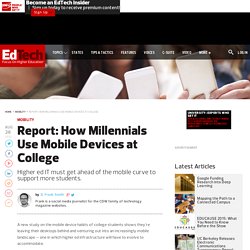
The survey from cloud provider Domo polled 2,228 higher ed students to see how they're using their mobile devices on campuses. Although the survey found that millennials spend more time browsing the Internet on their mobile phone than on their desktop, cellphone web surfing won by only a 2 percent margin (45.7 percent versus 43.4 percent for laptops or desktops).
Mobile device usage has been outstripping dedicated platforms like desktops and notebook computers since at least 2014, according to TechCrunch, which reported the results of a comScore study. Rising Earnings Disparity Between Young Adults with And Without a College Degree. National Issues Forum Guide: The Changing World of Work. AAC&U and Hart Research: 2015 Employer Survey. New Media Consortium: 2015 Higher Education Report. Lumina Foundation: What America Needs to Know About Higher Education Redesign. The College Payoff. Pew Research Report: Is College Worth It? College Presidents, Public Assess, Value, Quality and Mission of Higher Education Executive Summary.

Education: The Rising Cost of Not Going to College. For those who question the value of college in this era of soaring student debt and high unemployment, the attitudes and experiences of today’s young adults—members of the so-called Millennial generation—provide a compelling answer.

On virtually every measure of economic well-being and career attainment—from personal earnings to job satisfaction to the share employed full time—young college graduates are outperforming their peers with less education. And when today’s young adults are compared with previous generations, the disparity in economic outcomes between college graduates and those with a high school diploma or less formal schooling has never been greater in the modern era. Young Adults, Student Debt and Economic Well-Being. By Richard Fry Student debt burdens are weighing on the economic fortunes of younger Americans, as households headed by young adults owing student debt lag far behind their peers in terms of wealth accumulation, according to a new Pew Research Center analysis of government data.

About four-in-ten U.S. households (37%) headed by an adult younger than 40 currently have some student debt—the highest share on record, with the median outstanding student debt load standing at about $13,ooo. An analysis of the most recent Survey of Consumer Finances finds that households headed by a young, college-educated adult without any student debt obligations have about seven times the typical net worth ($64,700) of households headed by a young, college-educated adult with student debt ($8,700). While these stark differences in wealth accumulation are accounted for in part by outstanding student debt, that’s only part of the story. College is not a commodity. Stop treating it like one. Members of the campus community walk past Duke University Chapel.
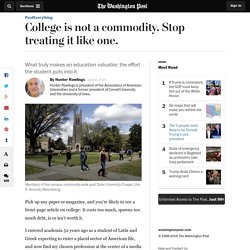
(Jim R. Bounds/Bloomberg) Pick up any paper or magazine, and you’re likely to see a front-page article on college: It costs too much, spawns too much debt, is or isn’t worth it. I entered academia 52 years ago as a student of Latin and Greek expecting to enter a placid sector of American life, and now find my chosen profession at the center of a media maelstrom. With college replacing high school as the required ticket for a career, what used to be a quiet corner is now a favorite target of policymakers and pundits. Here’s what I mean. Even on purely economic grounds, such questions, while not useless, begin with a false assumption. A college education, then, if it is a commodity, is no car. The results of this kind of thinking are pernicious. Pro tips: Declaring a college major. Despite Hurdles, Students Keep Switching Colleges - Students. By Katherine Mangan Some 3.6 million students entered college for the first time in the fall of 2008, at the height of the Great Recession.
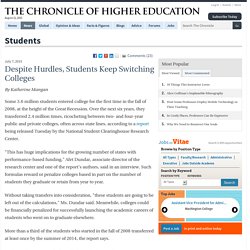
Over the next six years, they transferred 2.4 million times, ricocheting between two- and four-year public and private colleges, often across state lines, according to a report being released Tuesday by the National Student Clearinghouse Research Center. "This has huge implications for the growing number of states with performance-based funding," Afet Dundar, associate director of the research center and one of the report’s authors, said in an interview. Racial Wealth Gap Persists Despite Degree, Study Says. Fewer Good Jobs for College Grads? Not So, Says New Study - Administration. By Beckie Supiano The emerging conventional wisdom is that America's post-recession recovery was dominated by the rise of low-paying, part-time service jobs.
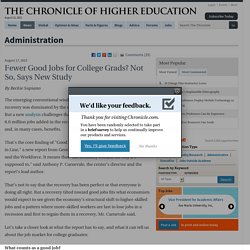
But a new analysis challenges that narrative, finding that 2.9 million of the 6.6 million jobs added in the recovery were "good jobs" providing high pay and, in many cases, benefits. That’s the core finding of "Good Jobs Are Back: College Graduates Are First in Line," a new report from Georgetown University’s Center on Education and the Workforce. It means that "the economy worked the way it’s supposed to," said Anthony P. Carnevale, the center’s director and the report’s lead author. That’s not to say that the recovery has been perfect or that everyone is doing all right. Why poor students drop out even when financial aid covers the cost. JUDY WOODRUFF: Next tonight, we begin our special week-long series Rethinking College.
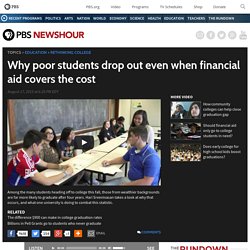
Across the country this month, thousands of students will head off to college, but statistics show that many will never make it to graduation, a vast number of them from low-income families. This week, the NewsHour looks at five experiments aimed at closing what is being called the graduation gap. We start with the University of Texas at Austin. DAVID LAUDE, Professor, University of Texas at Austin: There is a forward reaction, endothermic or exothermic? Endothermic.
These charts show what jobs liberal arts majors actually get. History majors go to law school.

Psychology majors go into social work. Music majors teach. We know this because the American Community Survey recently began collecting data on college majors. Ben Schmidt, an assistant professor of history at Northeastern University, used the survey's data on the 30 most common degrees and the 40 most common professions to create a giant interactive graphic last year on what Americans have actually done with their degrees. The big picture is overwhelming, but when you narrow it down to individual majors, you can see that many biology majors go to medical school: Cutting the liberal arts undermines our cultural traditions. Commencement at the University of Wisconsin at Madison in 2012.

(Andy Manis/For The Washington Post) By Kathryn Lynch June 19 Kathryn Lynch is an English professor and dean of faculty affairs at Wellesley College. It’s common to fret over unintended consequences. But what about intended consequences? In Wisconsin, lawmakers are debating a proposed change to state law that would weaken tenure protections at the University of Wisconsin system’s schools .
Little is being said, however, about the law’s explicitly stated purpose: to pave the way for the elimination of faculty appointments in fields that simply do not seem worth continued investment, not because a faculty member holds an unpopular or controversial opinion but because he or she teaches in a currently unpopular field. College Readiness Stagnates for Low-Income Students. Example Infographic: Faculty Challenge.
HERI: The American Freshman [sic] HERI: A Year Of Change 2014. HERI: Senior Survey 2014. Higher Education: Infographics (PINTEREST LOGIN REQUIRED)
Teaching with Infographics: Practicing New Digital Competencies and Visual Literacies. Abstract This position paper examines the use of infographics as a teaching assignment in the online college classroom. It argues for the benefits of adopting this type of creative assignment for teaching and learning, and considers the pedagogic and technical challenges that may arise in doing so. Data and insights are drawn from two case studies, both from the communications field, one online class and a blended one, taught at two different institutions.
The paper demonstrates how incorporating a research-based graphic design assignment into coursework challenges and encourages students' visual digital literacies. The paper includes practical insights and identifies best practices emerging from the authors' classroom experience with the infographic assignment, and from student feedback. Keywords: online learning, communications, graphic design, Internet research, peer-to-peer collaboration, teaching Introduction Technology in the Post-secondary Classroom Visual Pedagogy Teaching Case 1. SOCRATIVE.